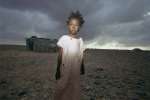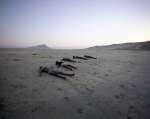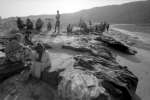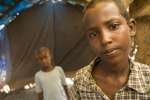- Text size
 |
|  |
|  |
| 
- Français
Deafness is no obstacle for refugee team in Dadaab
Telling the Human Story, 9 August 2012
DADAAB, Kenya, 9 August (UNHCR) – The cheering from their fans is unlikely to have much effect on this football team drawn from the five sprawling refugee camps at Dadaab: all the members of EL-MAN DEAF FC have limited or no hearing.
That has not stopped them playing well. Earlier this month – showing the Olympic spirit on a dry desert field far from the rain of Britain -- the team easily defeated a team of NGO and UN players 2-0. Tomoya Soejima, a UNHCR Youth Officer who works closely with the team, saw the victory as instilling further confidence.
The team is now ready to travel this month to the capital, Nairobi, to compete in a national tournament organised by the Kenyan football Federation of the Deaf (KFFD), in what for many players will be the first time they have left the refugee camps of north-eastern Kenya.
"I always dreamt of participating in a tournament and of bringing home a cup to my community," said Hussein Abdulai, the assistant coach who fled Somalia for Dadaab in 1991 and works as a primary school teacher in Ifo Camp.
'I remember the first ball we played with was made out of plastic bags and scrap paper. We started training every day and sometimes even joined the tournaments of 'hearing teams.'
"Years later we heard about the national tournament for the deaf and we immediately thought that this is our chance," he said. "We contacted Handicap International and asked for support. This is how it all started."
There are more than 12,000 people living with disabilities across the Dadaab refugee camps, which host a population of more than 470,000. Most suffer more than the average refugee and face challenges to access services because of discrimination or practical obstacles related to their disabilities.
"Very few agency staff and police officers know sign language, which can easily lead to confusion and miscommunication," said the first coach, also called Hussein Abdulai but from Hagadera camp. "One major concern is the insecurity in the camps with regular shootings and explosions of Improvised Explosive Devices.
"If there is a bomb exploding or if someone approaches me from behind how shall I know? I sometimes cannot fall asleep because I am afraid that something will happen during the night and I will simply not hear it."
It is therefore even more impressive when a team such as EL- MAN DEAF FC emerges, mobilizing supporters from all the camps.
"The players train once or twice per week in Ifo, Dagahaley and Hagadera camps and on the weekends, they all get together from the respective camps and have inter-camp tournaments, often also against "hearing" teams – and they still win," said Natha Yare Bashir, the team manager.
Many organisations and private donors have helped refugees to develop their skills in sports, including Nike, Right to Play, Handicap International, CARE, Alive&Kicking and UNHCR.
UNHCR and its partners launched the Dadaab Sport Initiative 2012, which reached out to more than 10,000 youths who were out of school to provide training, workshops, and equipment. Across the camps women, girls, men and boys play volleyball, football and other sports
Sport is important, not just for physical fitness but for strengthening the bonds between people. In the refugee camps and surrounding areas sport has become an important way to build peace and give people confidence in their skills and worth as human beings.
"We will give our utmost to succeed in the tournament," said a smiling Hussein Abdulai. "But even if we lose, we will still make Dadaab proud."
Bettina Schulte, Andreas Kiaby and Tomoya Soejima in Dadaab















































